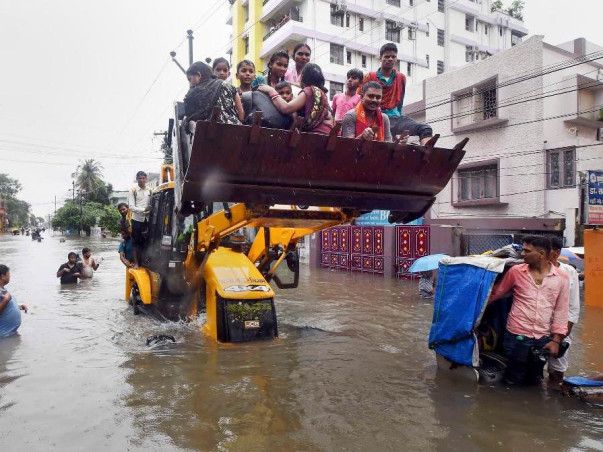Hello Everyone,
Students groups of Patna stand from last days with the public of Patna. Although, all of them are just students so they don't much more funds to help the people so we decided to help them by collecting the funds and crowdfunding.
Students groups of Patna stand from last days with the public of Patna. Although, all of them are just students so they don't much more funds to help the people so we decided to help them by collecting the funds and crowdfunding.
We are looking more supporting hands across the country to revive the life of Patna on the track within a few days.
How funds will be used?
1. Funds will be used to Support for helping Flood Affected People in Patna in an immediate Response.
2. Funds will be used to buy Water Bottles, Foods and Medicines.
3. Funds will be used to buy milks and other things for flood affected people.
4. Funds will be used to provide medical assistance.
Story of Patna Floods
Large parts of Patna are facing a flood-like situation, with water entering homes and people being rescued in boats. Thirty-two people have died so far, while hundreds including the deputy chief minister of Bihar, Sushil Kumar Modi, had to be rescued. What led to these floods? It is not a result of rivers breaching their banks and entering the city. The cause is a four-day deluge, the highest in 119 years, after three months of deficient rains this monsoon season.
Story of Patna Floods
Large parts of Patna are facing a flood-like situation, with water entering homes and people being rescued in boats. Thirty-two people have died so far, while hundreds including the deputy chief minister of Bihar, Sushil Kumar Modi, had to be rescued. What led to these floods? It is not a result of rivers breaching their banks and entering the city. The cause is a four-day deluge, the highest in 119 years, after three months of deficient rains this monsoon season.
 An HT analysis of daily rainfall data from the India Meteorological Department (IMD) shows that total rainfall in Patna between 26 to 29 September was 210.8 mm. The five years that come closest to the 210.8 mm rainfall received in the September 26-September 29 period in 2019 are 1963 (198.1 mm), 1960 (136.1 mm), 2007 (126.7 mm), 1989 (117.8 mm), and 1902 (116.8 mm).
An HT analysis of daily rainfall data from the India Meteorological Department (IMD) shows that total rainfall in Patna between 26 to 29 September was 210.8 mm. The five years that come closest to the 210.8 mm rainfall received in the September 26-September 29 period in 2019 are 1963 (198.1 mm), 1960 (136.1 mm), 2007 (126.7 mm), 1989 (117.8 mm), and 1902 (116.8 mm).To be sure, Patna is not the only city which has received abnormally high rainfall in the state of Bihar. The state has received 181.9mm of rainfall from 26 to 29 September, which is significantly higher than the top five high rainfall years on these days. The state’s rainfall (181.9 mm) appears smaller than the rainfall in Patna (210.8 mm) because rainfall for an area is the area-average of rainfall for its constituent units. For example, if Bihar was made up of two equal districts that received 50 mm and 0 mm rainfall for four days consecutively, the rainfall for Bihar as a whole would be (50+0)/2 mm or 25 mm for each of those four days. The total rainfall for Bihar for this four-day period would be 25*4 mm or 100 mm. The rainfall for the two units for the four-day period would be 50*4 mm and 0*4 mm or 200 mm and 0 mm.
 What’s ironical is the fact that total rainfall this year in both Patna and Bihar is less than the Long Period Average (LPA) rainfall. The total rainfall in Patna and Bihar was only 86% and 98% of LPA between June 1 and September 29. LPA is average rainfall between 1951 and 2000.
What’s ironical is the fact that total rainfall this year in both Patna and Bihar is less than the Long Period Average (LPA) rainfall. The total rainfall in Patna and Bihar was only 86% and 98% of LPA between June 1 and September 29. LPA is average rainfall between 1951 and 2000.If the week after September 25, 2019 is excluded, the monsoon rainfall for Patna and Bihar comes to -35% and -18% respectively. Another metric can be given to highlight the skewed nature of rainfall in Bihar this year. Out of the 121 days in the 2019 monsoon —June 1 to September 29 — for which daily rainfall data is available for Bihar, 90 days saw lower-than-average rainfall in the state.
Within the state, there were regional differences. For example, although the state has received normal rainfall, seven of 38 districts (Arwal, Begusarai, Sheikhpura, Saharsa, Munger, Lakhisarai, and Katihar) remained rainfall deficient as on September 29. This means that the total rainfall received in these districts was 20% or more below the LPA. All these districts received “large excess” rainfall on September 29. Only four districts in the state — Buxar, Samastipur, Siwan, and Gopalganj — have received excess rainfall this monsoon. Almost three-fourths of the state (27 of 38 districts) will likely continue to be in the “normal” category this monsoon unless the rainfall on Monday can cover the gap to the 20% or above values of the districts’ respective LPA.
Flood News : https://www.hindustantimes.com/india-news/patna-flooded-but-monsoon-rainfall-still-below-normal/story-KLYhZErwsgAxQAyF6y4ahM.html







